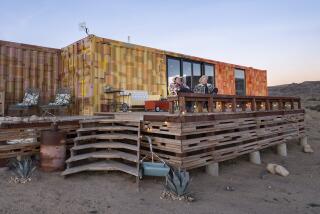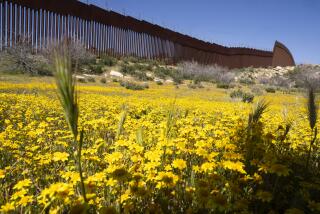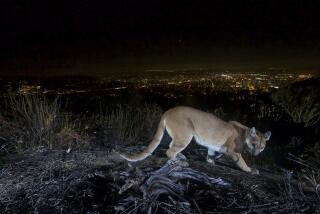From his pen flows the Sierra Nevada
YOSEMITE NATIONAL PARK -- He took his first hike into the Sierra Nevada, the landscape of his obsession, while still in the womb. His parents named him John Muir Laws. He once spent a week searching for a single perfect orchid to paint. He says, “I am constantly amazed by things.” Such as? “The diversity of chipmunks.” He is not joking. He cares about newts. If asked, he does an excellent imitation of a startled vole. He has opinions about beetles.
In the fall, he published “The Laws Field Guide to the Sierra Nevada.” It is 366 pages long and contains 2,800 illustrations, each painted by Laws. The new field guide, already praised by outdoor connoisseurs as a naturalist’s bible, begins with “Small Fungi Growing on Wood” (specifically, Calocera cornea, the staghorn jelly fungus) and ends with stars (the night sky at winter solstice). It is small enough to slip into your pocket but includes 1,700 species of flowers, trees, bugs, frogs, snails, skinks, birds, fish and rodents. It took him six years to research and complete. The world needs more of this -- this kind of sustained, informed, deep gee-whizdom.
Not too long ago: Laws is scrambling on a footpath near the eastern entrance to Yosemite National Park. Suddenly he stoops. “Well, would you look here,” he says. “A nice one.” He holds up a fat, ashy dried cigar, the kind a dictator might smoke, and admires a perfectly formed black bear scat. Flip to Page 326 and there it is, a painting of the plop. There are two pages devoted to “Animal Evidence” in his field guide. Did you know that professionals call the indentations and depressions in deer droppings “dimples” and “pimples”? Now you do.
The release of a major new field guide, especially for an ecosystem as popular as the Sierras, is an event for people who may care about such things, meaning people who want to know what they’re looking at, the showy penstemon or the gay penstemon? Because there is a difference (hairless versus hairy stems, apparently; see Page 150).
The Sacramento Bee praised the Laws guide as “a wonderful companion to anyone who communes with nature on hikes, on the water, while bird-watching or even through the windshield for those less able to get out into the hills.” The San Francisco Chronicle called it “stunning.” Pete DeVine, the education coordinator for the Yosemite Association, says, “There is genius behind this book.”
Stunned by beauty
There is also something sweet and obsessive, and marvelously 19th century about the whole enterprise, the idea of a lone amateur, now 41 years old (living in a rented $600 apartment in San Francisco), spending season after season tramping around the mountains, painting mushrooms and moles. “The pages and pages of bugs, flies, beetles,” says Malcolm Margolin, founder of Heyday Books in Berkeley, the nonprofit publisher of the field guide. Margolin says he may not be able to “tell one from another, but isn’t it wondrous that they’re out there? Isn’t that marvelous?”
“I’m a beauty junkie,” he adds. “And this book was done by somebody who is stunned by the beauty of the world.”
The Appalachians? The Rockies? No disrespect, but the Sierra Nevada is the prettiest postcard in America. It is just a sublime landscape, the granite spire above alpine meadow against the bluest sky. The Sierras are Byron meets Monet meets Maxfield Parrish. They’re over the top. Even in the black and white of an Ansel Adams print, the Sierras work. About 400 miles from bottom to top, the range includes nine national forests, three national parks (Sequoia, Kings Canyon, Yosemite) and the highest point in the contiguous United States (Mt. Whitney, 14,505 feet). It is the setting for the original John Muir rhapsodies of natural history writing and a birthplace of the modern American conservation movement -- including the Sierra Club.
Laws is walking on the trail. “Whitebark pine,” he points out (Page 33). “Check this out.” He is on his knees rustling around in the duff beneath a stunted tree. “See? Look at all the pine cones.” We are looking: many cones. But are we really seeing?
“Not a single one intact,” says Laws. And, aha, he is correct: All the cones appear . . . aggressively tweezered. Now Laws begins screeching. “Kaa-a! Kaa-a!”
“A rowdy call, a raucous call. I love that description, don’t you? Rowdy?” He is talking about the call of the Clark’s nutcracker (Page 292), the bird that plucks and then buries these pine nuts for the winter. Laws is explaining that these particular nutcrackers carry the seeds underneath their tongue in a special cavity called the gular pouch, like a pelican. The huh pouch? How do you spell that? Laws thinks that is funny. Why?
“Don’t ask a dyslexic how to spell,” he says. So now we know. It turns out Laws has never read a book cover to cover. Words are a jumble to him. To get through school, he listened to books on tape and textbooks recorded for the blind. (Though it did not stop him from getting his undergraduate degree at Berkeley and his master’s in wildlife biology from the University of Montana; he earns his living teaching classes on natural history, scientific illustration and field sketching.)
“He is an absolutely wonderful misspeller,” says his father, Robert Laws, a retired San Francisco attorney. “I think his dyslexia is the key.”
Meaning a key to his book. “Maybe that’s what makes me who I am,” Laws says. “If I had the option, I don’t think I would cure it.” Because maybe his dyslexia helps him see more, better, or differently.
Organized by color
Most field guides are organized, essentially, around the expert’s division of life forms into their taxonomic, evolutionary groups -- all gulls with gulls, all hawks with hawks, for example, which requires the searcher to know, a little bit, where to look in the book. But Laws has devised a clever way to organize his field guide by color.
You see a bird. You see a greenish bird. You go to the color key and flip to “Green Birds,” and the guide lists birds whose dominant, most eye-catching color is green -- combining Anna’s hummingbirds, green-tailed towhees and Lewis’ woodpecker on the same page. It is a fast, intuitive, accessible way to do snappy identifications in the field.
Telling the story
Laws painted every wildflower in his book from sketches and paintings in the field. The same with most of the birds, except the great horned owl, which he kept missing. “We have this idea that all robins, for example, look the same,” says Laws. “But they don’t. . . . It’s because we’re not looking hard enough.”
For the fungi, he went on collecting trips with mycologists, who piled fresh specimens onto a table. He sought out authorities on animal tracks, aquatic insects, butterflies, snakes. Researching, Laws would spend weeks alone in the mountains. How many miles did he hike? “That’s hard to answer,” he says. In the beginning, it would take him several days just to cross a single meadow, because he would stop and sketch each new flower. “But toward the end of the project, I’d hike for hours just to find one new thing.”
There are many creatures he never drew in the wild. He never saw, for example, a spotted skunk. He painted one from a roadkill. “I haven’t seen all the species of chipmunks nor all the bats,” he says. He painted them from dead specimens kept in museum collections. He never saw a wolverine either. They are believed to be extirpated in the Sierra Nevada (the last one spotted in 1937), though he includes one in his book with a note to report a sighting to the California Fish and Game Department.
When he was a boy, hiking on the John Muir Trail, he dreamed of creating the perfect field guide, not a guide made by experts but a book by an enthusiast. “My criteria for inclusion in the book: Either it’s so common you’ll trip over it all the time. Or not so common -- maybe it’s just some subtle little thing, but they are so stunning or their story is so great, I had to include it,” he says.
Why? “Because the more people fall in love with the diversity of life, the more people will fight to protect it,” Laws says. Do you know, he asks, the story of the pika, which is actually a hamster-size rabbit with round ears, whose nitrogen-rich urine is like some kind of Miracle-Gro for orange lichen (Page 313)? The pika collects grass and flowers on the rocks above the timberline and dries them in the sun.
The cold-loving pika may become extinct because it lives at the tops of mountains, and as the temperature warms, it has no higher elevation to go to.
So it’s like a polar bear in a melting world, except it’s a tiny rabbit that cooks? Exactly, says Laws.
“The point really is not to identify a creature or a plant and move on. The point is to learn the story.”
More to Read
Sign up for The Wild
We’ll help you find the best places to hike, bike and run, as well as the perfect silent spots for meditation and yoga.
You may occasionally receive promotional content from the Los Angeles Times.






